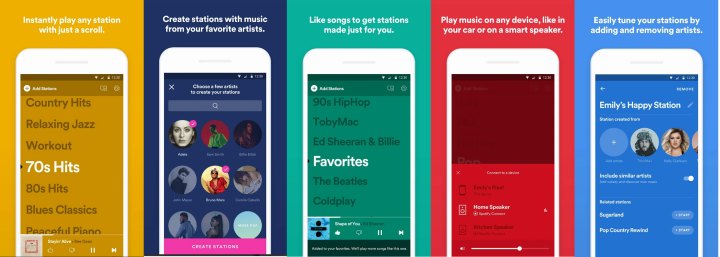
Spotify might be the streaming music king globally, but in the U.S., it faces massive competition. Pandora remains the leader, and Apple Music is proving impressively capable, especially in its ability to add and retain paid subscribers. In the face of this challenge, Spotify’s response involves a series of so-called experiments, including a stand-alone app called Stations, which breaks out one part of the larger Spotify service into its own experience. The Stations app has been available abroad for a while now — it launched in Australia in 2018 — but this week it arrives in the U.S. on iOS and Android.
With Stations, both free and premium Spotify subscribers get an app that is tightly focused on getting you listening to music immediately, with as little effort as possible. In fact, all you need to do to start listening is to launch the app. Want a different playlist? Simply tap one of the large, easy-to-see Stations. To get a more personalized experience, indicate your preferences by liking tracks as they play and Stations will build a personal Favorites station. You can also create your own custom stations from scratch by picking a few artists to start, and then adding or removing artists over time. Free users will hear ads and receive limited song skips, while premium subscribers get an ad-free experience and unlimited skips.
As an experiment, Stations joins other efforts like Spotify’s Car Thing, personalized playlists, podcast playlists, and a couples-oriented subscription plan called Duo. On a superficial level, Stations appears to be a shot across the bow at Pandora, which has always benefited from its own stations feature. But Stations has been a Spotify feature for years, much as Messenger was a Facebook feature for ages before Facebook decided to create a Messages stand-alone app. Breaking Stations out into its own experience — while not removing it from the main Spotify app — is a way for the company to better leverage one of its most valuable assets, while acknowledging that not everyone who wants to listen to music, wants the same experience.
In the deepening three-way battle for U.S. streaming supremacy, Stations could give Spotify the edge it needs to attract more free (yet ad-supported) subscribers, which it can ultimately convert into paying, premium subscribers.



